Pick of the Brown Bag
December 12, 2019
by
Ray Tate
Welcome to the Pick of the Brown Bag a weekly review blog for comic books. My name is Ray Tate, and this week I take a peek at The Butcher of Paris, Captain Marvel, Detective Comics, Dejah Thoris, Fantastic Four, Far Sector, Friendly Neighborhood Spider-Man, The Immortal Hulk, Mary Jane, Miles Morales Spider-Man, Tommy Gun Wizards and Vampirella and Red Sonja.
If you can't be here for the blog, check out the itsy-bitsy teeny weeny reviews on Twitter: #PickoftheBrownBag.
The Butcher of Paris is based on a true crime that I've never saw dramatized until now. It’s the tale of Marcel Petiot, an organized serial killer operating during World War II.
The story opens in Vichy France. For those not in the know, this is the time period of Nazi control. Indeed Stephanie Phillips’ story opens with matters of the Fatherland.
Monsieur Dreyfus is one of many dedicated to rescuing Jews from Nazi tyranny. Note the small talk amongst the Gestapo. Phillips makes no effort to humanize Nazis. They are the distillation of evil in her story, as history reflects.
The Krauts take their prisoner to the Surete. There the Nazis demonstrate even more typical behavior.
The Krauts take their prisoner to the Surete. There the Nazis demonstrate even more typical behavior.
The hunt for an Underground Railroad for Jews, using Dreyfus as a stalking horse leads the Nazis and the constabulary to a gruesome discovery.
There’s a frequent attempt to show honor in Nazis. As if intellect alone can pierce through a brutal lust for murder. The Nazis however lacked a scintilla.
Phillips holds a mirror up to the Nazi ideal. It’s ugly. Her matter of fact dialogue, her lack of flourishes to the same gives the entire affair a docudrama feel.
In John Carter Warlord of Mars Attacks artist Dean Kotz had a blast depicting cartoony humans, ghoulish Martians and boisterously outlandish violence. Accompanying Phillips, Kotz transforms his style into a kind of court room rendering. Thus, we receive the perfect union of art and story appropriate for historical atrocity.
Phillips holds a mirror up to the Nazi ideal. It’s ugly. Her matter of fact dialogue, her lack of flourishes to the same gives the entire affair a docudrama feel.
In John Carter Warlord of Mars Attacks artist Dean Kotz had a blast depicting cartoony humans, ghoulish Martians and boisterously outlandish violence. Accompanying Phillips, Kotz transforms his style into a kind of court room rendering. Thus, we receive the perfect union of art and story appropriate for historical atrocity.
From a magical realm, the hunted Toad fled to earth. Unfortunately the first person he met was Al Capone.
The real Al Capone was a murderous mob boss that united the gangs and distributed smuggled alcohol illegal under the Volstead Act. Understand booze was a means to an end. The booze was immaterial. The Volstead Act a mere catalyst. If the government had banned rhubarbs, Al Capone would have been known as a rhubarb racketeer.
The ban created a demand. The demand created opportunity for Capone. In Tommy Gun Wizards, the government bans a magical elixir called the Lick.
The real Al Capone was a murderous mob boss that united the gangs and distributed smuggled alcohol illegal under the Volstead Act. Understand booze was a means to an end. The booze was immaterial. The Volstead Act a mere catalyst. If the government had banned rhubarbs, Al Capone would have been known as a rhubarb racketeer.
The ban created a demand. The demand created opportunity for Capone. In Tommy Gun Wizards, the government bans a magical elixir called the Lick.
The Toad produces the Lick in the same way terrestrial amphibians produce psychedelic substances. The Toad however needs magic to become so common that there will be enough energy in the atmosphere allowing him to open a portal. The Toad isn’t the villain. He's an alien. He just wishes to go home.
Eliot Ness and his Untouchables as they did in real history wage a war against Capone. The witchery is a distraction to their true purpose. Destroying crime.
The blend of magic and mobsters is utterly brilliant. Spells uniquely manifest as entities, and this twist on traditional sorcery plays a big part in the story. The time honored pulp devices of alliances and double-crosses adds spice and unpredictability to the brew. The sorceress Candice a former acquaintance of Eliot Ness engagingly plays both sides. Ness a master Lick user himself comes off as an arch wizard. In the end Ness’ loyalty to his fellow agents proves vital. A highly entertaining series well worth your time.
Created by Edgar Rice Burroughs, Dejah Thoris "daughter of ten thousand Jeddaks," is the wife of John Carter Warlord of Mars. Burroughs introduced her in The Princess of Mars. She co-starred in two more novels before becoming a secondary character.
Dynamite Comics took the opposite direction. Dejah became the focus of her own long-lasting series and various miniseries before they ever introduced John Carter as one of the cast. I wonder if Disney's film had something to do with this decision. In any case, Dejah Thoris became a hit.
Dan Abnett scribes the latest volume of Dejah’s chronicles, and he's the main reason why I chose to try Dejah Thoris. In short, not bad.
Abnett sees numerous parallels to our earth in Burroughs' Barsoom. Abnett for example opens the story with Dejah investigating climate change.
Form the onset, you knew Barsoom was dying. John Carter awakens on Barsoom amidst yellow moss that's evolved from that of dead seas. Incidentally, Burroughs introduced Dejah as a scientist. This is not a nod to modern sensibilities. She will in fact appear as a less clothed scientist as the story progresses.
Unlike our earth, the advanced technology of Mars provides sole survival. The city-states allow for atmosphere and water. I always imagined the nations somehow contained either by Atlantean like bubbles or science fiction force fields. I could never wrap my head around an artificially produced atmosphere blanketing an open system without spreading thinner.
Dejah brings her findings to the new Jeddak Kurz Kurtos, Abnett's creation, who is less than receptive.
If you have a conscience, you’ve been psychically wounded by the presence of Donald Trump in the White House. Abnett’s therapy lies in his comic book writing. He addressed Trump in Aquaman. He does it now in Dejah Thoris. Alternately, maybe he’s just basing his new Jeddak on the vainglorious rulers of yore, and I’m seeing the parallels.
Such as the rival city-state Zodanga, a Burroughs creation, being a mirror to Russia. Whatever the reason, this back-stabbing, climate change denying Jeddak wants his former rational, benevolent ruler gone. Kurz begins to hatch a plot with his advisor to assassinate Dejah Thoris.
Amidst the political intrigue, fans of the Burroughs' novels will take heart in familiar faces and creatures. Tars Tarkas obviously. Dejah’s right hand man Kantos Kan serves by her side.
Dejah’s and John Carter's daughter Tara and granddaughter Llana of Gathol depicted above make appearances. If you're wondering how about the ages. Red Martians live for about one thousand years. John Carter consistently arrives on Mars forever young. Burroughs also granted a longer life span to Tarzan and Jane, who have a near adult son named Korak. Burroughs appeared to want to write about these characters for as long as he had ideas. He wanted to do so without having to worry the realities of aging. That's apparent when you see youthful grandmothers, mothers and old daughters side by side.
Dynamite Comics took the opposite direction. Dejah became the focus of her own long-lasting series and various miniseries before they ever introduced John Carter as one of the cast. I wonder if Disney's film had something to do with this decision. In any case, Dejah Thoris became a hit.
Dan Abnett scribes the latest volume of Dejah’s chronicles, and he's the main reason why I chose to try Dejah Thoris. In short, not bad.
Abnett sees numerous parallels to our earth in Burroughs' Barsoom. Abnett for example opens the story with Dejah investigating climate change.
Form the onset, you knew Barsoom was dying. John Carter awakens on Barsoom amidst yellow moss that's evolved from that of dead seas. Incidentally, Burroughs introduced Dejah as a scientist. This is not a nod to modern sensibilities. She will in fact appear as a less clothed scientist as the story progresses.
Unlike our earth, the advanced technology of Mars provides sole survival. The city-states allow for atmosphere and water. I always imagined the nations somehow contained either by Atlantean like bubbles or science fiction force fields. I could never wrap my head around an artificially produced atmosphere blanketing an open system without spreading thinner.
Dejah brings her findings to the new Jeddak Kurz Kurtos, Abnett's creation, who is less than receptive.
If you have a conscience, you’ve been psychically wounded by the presence of Donald Trump in the White House. Abnett’s therapy lies in his comic book writing. He addressed Trump in Aquaman. He does it now in Dejah Thoris. Alternately, maybe he’s just basing his new Jeddak on the vainglorious rulers of yore, and I’m seeing the parallels.
Such as the rival city-state Zodanga, a Burroughs creation, being a mirror to Russia. Whatever the reason, this back-stabbing, climate change denying Jeddak wants his former rational, benevolent ruler gone. Kurz begins to hatch a plot with his advisor to assassinate Dejah Thoris.
Come on. That’s Trump in a nutshell, yeah?
Amidst the political intrigue, fans of the Burroughs' novels will take heart in familiar faces and creatures. Tars Tarkas obviously. Dejah’s right hand man Kantos Kan serves by her side.
Dejah’s and John Carter's daughter Tara and granddaughter Llana of Gathol depicted above make appearances. If you're wondering how about the ages. Red Martians live for about one thousand years. John Carter consistently arrives on Mars forever young. Burroughs also granted a longer life span to Tarzan and Jane, who have a near adult son named Korak. Burroughs appeared to want to write about these characters for as long as he had ideas. He wanted to do so without having to worry the realities of aging. That's apparent when you see youthful grandmothers, mothers and old daughters side by side.
This issue of Vampirella and Red Sonja spotlights the latter hero. In a tale pre-Vampirella, Red Sonja finds herself amidst a band of men who have a beef with an old witch woman.
When one mortally wounds the witch, Sonja goes after her. She finds herself becoming Alice in a situation that becomes curiouser and curiouser.
Upon discovering the wounded witch, Sonja determines less a dangerous creature and more of a person in need.
Although this Sonja is as bona fide as other versions, writer Jordie Balliere and artist Drew Moss present her as softer and more caring. Even Amy Chu’s Red Sonja, easily the most modern, for reasons other than her teleportation to current day, wasn’t so empathic.
The wounded witch seeing something in Red Sonja gifts her a magic stone that will become pivotal in her future life with Vampirella.
Mary Jane Watson combines forces with a disguised Quentin Beck to make his biopic and give herself a plum role. The duo combat the deadly forces of bounced checks, equipment repo and in this issue a group of all-too real Spider-Man villains who feel their parts in the picture aren’t all that.
The hilarious issue features escapes in golf carts, prop trucks and a beautiful comeuppance for all involved in squashing Mysterio's dreams.
Red Sonja's Carlos Gomez illustrates, and while his babes are gorgeous, the prize goes to the introduction of all-around actor Sonny Diperna.
Gomez bestows poise and an aura of astounding coolness to Diperna. Writer Leah Williams makes him party to an inside joke based on a Leonard Nimoy trick. The unflappable Diperna just stands out like an A-List celebrity should. More surprises and guest-stars from the Marvel Universe await readers in this upbeat comedy well worth your time.
Red Sonja's Carlos Gomez illustrates, and while his babes are gorgeous, the prize goes to the introduction of all-around actor Sonny Diperna.
Gomez bestows poise and an aura of astounding coolness to Diperna. Writer Leah Williams makes him party to an inside joke based on a Leonard Nimoy trick. The unflappable Diperna just stands out like an A-List celebrity should. More surprises and guest-stars from the Marvel Universe await readers in this upbeat comedy well worth your time.
Remember. In one of the dumbest moments in Spidey’s oeuvre Pete swapped out his happiness with Mary Jane for Aunt May’s life. MJ features prominently in Spidey’s life. So it’s not too big of a leap to associate the Bic C with Spidey becoming closer to MJ. Oh, and It's not dumb that Peter saved Aunt May. It's dumb that contrived hackery forced the choice. Hope that's clear.
Although personally I feel there’s a loophole in all of this. Spider-Man isn’t the same Spider-Man who made the deal. The Marvel Universe changed after Battle World. Anyhow, this is nevertheless a sweet story about Spidey being there for his Aunt May.
Writer Tom Taylor first demonstrates that Peter’s Aunt used to be young and Marisa Tomei vibrant, yet she assumed the responsibility for caring for her orphaned nephew.
When the lights go out, Spidey's responsibility meter kicks in. He suits up and finds he's not needed at all.
It's really nice to see Spidey so loved. Too often comic books like to create schisms between super-heroes. It's just great that Iron Man, Heroes for Hire, Rumor, Miles and the FF care enough about Spider-Man to help him when he needs it. Even the force behind the blackout thinks he owes Spider-Man a debt.
It's really nice to see Spidey so loved. Too often comic books like to create schisms between super-heroes. It's just great that Iron Man, Heroes for Hire, Rumor, Miles and the FF care enough about Spider-Man to help him when he needs it. Even the force behind the blackout thinks he owes Spider-Man a debt.
The Prowler is Miles Morales’ Uncle Aaron. To safeguard his nephew, Aaron took on a hit-job. Miles stopped him, but in so doing he started a John Wick like chain of dominoes. Now, everybody and their aunts are out to kill the Prowler and anybody else that gets in the way.
That includes Miles. It’s a freewheeling gauntlet that allows writers Saladin Ahmed and artists Javier Garron, Kevin Libranda, Alisha Martinez and David Curiel to pull in a cadre of D-List Spider-Man antagonists.
The creative team furthermore surprise the reader with the return of a Miles Morales ally, swooping in at an opportune moment. The ultimate solution on how to alive the heat works well within the rules of engagement, and just in time for Aaron to meet his new niece. The story should feel rushed, but the pacing is perfect, the time-saving twists clever and plausible.
The Immortal Hulk upends traditional heroism while advancing the Hulk’s and Banner’s intention to change the earth by destroying the human world of greed.
On one front, Dario Aggar the head of Roxxon Oil must deal with the Hulk’s mortal wounding of the corporation. He killed the company’s servers.
On one front, Dario Aggar the head of Roxxon Oil must deal with the Hulk’s mortal wounding of the corporation. He killed the company’s servers.
Nope. Not taking it well at all. Meanwhile, a smaller story unfolds as a cop father feels alienated by his teenage daughter.
Much like many of the GOP who are dead set on metamorphosing the country back to a mythical Utopia based loosely on the fifties, the cop wonders where it all went wrong. Where did the little girl that he loved go?
The fact is she went nowhere. The little girl he loved is right there in front of him. He just can’t embrace or support the changes she made. Listen if your child isn’t a criminal, nor physically damaging themselves, you should accept them unconditionally. I’m not a parent, nor the most savvy people person, and even I know that.
The fact is she went nowhere. The little girl he loved is right there in front of him. He just can’t embrace or support the changes she made. Listen if your child isn’t a criminal, nor physically damaging themselves, you should accept them unconditionally. I’m not a parent, nor the most savvy people person, and even I know that.
The conflict leads to a pivotal heroic save by the Hulk. The way the story evolves is wonderfully organic. There’s not a hint of disbelief suspension needed. The surprise behavior of the antagonist doesn’t really seem absurd. It’s a surprise that develops from within the antagonist’s personality and microcosmic proof that the Hulk is right.
Reed, Sue, Ben and Johnny recreated their historic journey that ended when being hit by cosmic rays. A Tac-Tac-Tac-Tac-Tac later and the Fantastic Four were born. This time with better shielding, the FF succeed. Their first stop is the planet Spire.
Advanced science foretold The FF’s journey, but the science fiction runes portrayed them as destroyers. So the elder statesmen irradiated the denizens with the same cosmic rays that granted the Fantastic Four their abilities.
When the FF arrived, an all-too convenient communications failure and the prediction sent them speeding headlong into the path of Spire’s champions.
Spire is in many ways like earth. With a dominant humanoid population but more commonplace futuristic tech. They also have one odd custom.
Doctor Who’s Time Lords as children stare into the schism, the raw time/space vortex, to discover great wisdom, great madness or great terror. The People of Spire look into a different cosmic sigil to find their soulmates.
The entire conflict between the FF and the People of Spire arises from the foundation of their culture. The sight triggered a government edict on genetic experimentation. Reed and Sue are appalled.
The process also creates less than shiny super-heroes. As a result, Spire creates a caste culture, disposing of the unwanted in an underground where they need not be seen. That’s where Ben Grimm comes in.
I dismissed the first chapter of this story as just another FF versus throwaway analogs of the Avengers. I also thought they may turn out to be the Thunderbolts. The heroes of Spire need a little more meat to them. They however distinguish themselves from other super teams. No, they're not the Thunderbolts. I was wrong about that.
No matter what though that first chapter was too dull. It’s a pity. These latest issues exemplify excellent, thoughtful and humorous science fiction, offering the Fantastic Four at their best.
I’m still not a fan of this Captain Marvel story, but at least it gives writer Kelly Thompson a means to reintroduce the concept of A-Force.
She and the editor also admit that you’re unlikely to know what a Vox Supreme is, and that it's never bothered Carol before. They furthermore come clean about Carol killing the Avengers relatively quick. No. She's not actually murdering her teammates and friends.
That said, I’ve never been interested in superheroes fighting. So, this is really boring to me and not what I signed up for.
Well, alright. At least Sojourner Mullein thinks she’s a Green Lantern. I kind of hope she is. Though she’s not a typical Lantern.
That’s probably why the Guarians assigned her to be the marshal of the Far Sector. Currently she investigates a murder that solved itself. Kind of.
The question now is who killed the killer and why? The roads seem to lead to the grand poobahs of the alien species that cohabit a Dyson Sphere conglomerate formed by the survivors of war. The science fiction setting offers a visual feast that artist Jamal Campbell brings to life.
The aliens identified their conflict as emotional. So to broker a true peace, the aliens nullified their emotions. That surprisingly doesn’t stop them from getting lucky.
Sometimes in the strangest of ways.
The differences in species generate potential motives, opportunities and humor. Green Lantern Mullein compliments this diversity with intellect and curiosity.
Detective Comics presents a missing persons mystery that affects Bruce Wayne as much as Batman. The story begins at the Martha Wayne Orphanage.
A youth runs from the sanctuary, and Lucius Fox, conspicuously taking the place of Alfred, convinces Batman that the missing youth is his problem.
As Bruce Wayne, Batman visits the orphanage and fulfills his responsibility as the patron.
His meeting with the director of the orphanage is uninteresting, but he gathers what facts he can before heading out into the night as Batman. Because Batman cannot divide his attention, he calls in his son Damien Wayne, Robin to take the lead.
Robin eventually discovers the teen’s whereabouts, and he and Batman both discover something wrong at the orphanage.
This is a bravely dark story with a purposeful wintery atmosphere by the Phantom's Fernando Blanco. It at once shows Batman and Robin at their best and their most mortal.
This is a bravely dark story with a purposeful wintery atmosphere by the Phantom's Fernando Blanco. It at once shows Batman and Robin at their best and their most mortal.


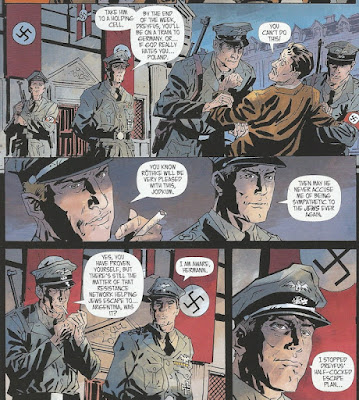
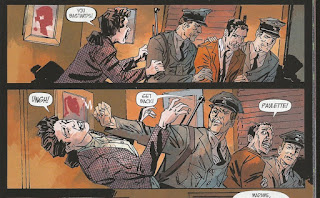



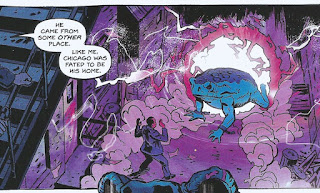













































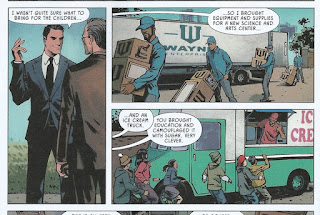
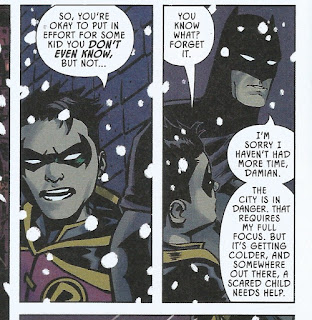

No comments:
Post a Comment